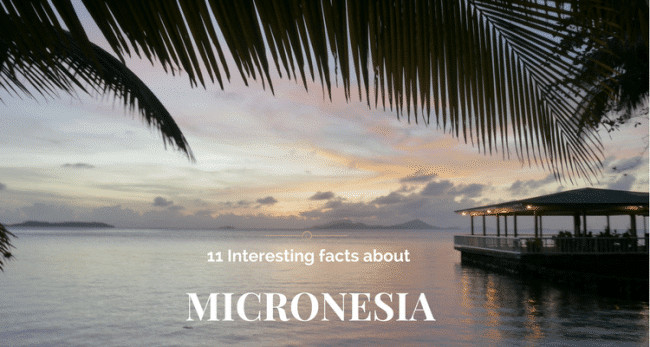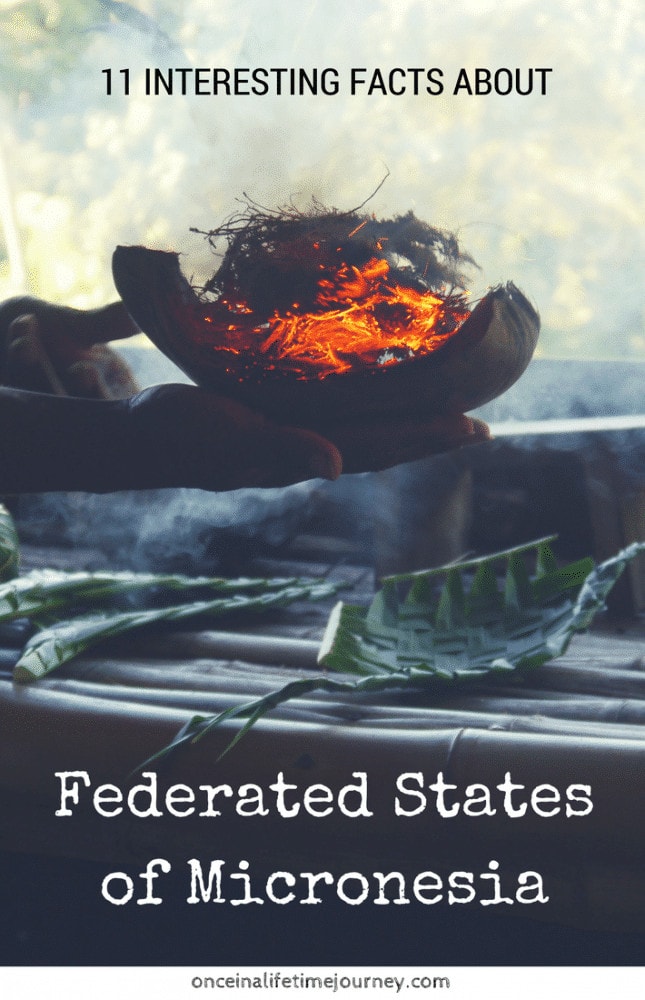The Federated States of Micronesia (FSM) is a group of islands in the Pacific Ocean located between the Philippines and Hawaii and south of the island of Guam, a US Territory. Geographically, the FSM is part of the archipelago of the Caroline Islands, a scattered group of islands that were included in a UN Trust Territory under US protection after WWII. For such a small country, Micronesia is full of interesting facts.
Whereas many of these islands are still US territories and protectorates, the four states of Chuuk, Pohnpei, Yap and Kosrae that form the FSM drew a Constitution in 1979 and became an independent country in 1986. Palau also decided to be an independent country and used to be the world’s youngest country until South Sudan was formed in 2011. Their remoteness and the limited amount of travelers who visit, is the reason why I am fascinated by this part of the world. After having collected some really rare passport stamps by traveling through the South Pacific extensively, from the Solomon Islands to Vanuatu, Fiji, Samoa, Tonga, American Samoa, French Polynesia and The Cook Islands, I wanted to explore the North Pacific. So here are some interesting facts about Micronesia.
1. Its existence
Chances are you have never heard of Micronesia or the federated States of Micronesia. Micronesia is a group of over 600 islands in the North Pacific that include Guam, the Federated States of Micronesia and Saipan among others. It is not to be confused with the Federated States of Micronesia, an independent country that is also part of the Caroline Islands and the Micronesia archipelago as I was mentioning before. FSM receives less than 45,000 visitors a year, most of which are divers, and that makes it one of the least visited countries in the world so it is only fair that you never heard of it.
2. Close to the US but independent
Before the country became independent in 1979 it used to be under a UN Trust Territory under US administration following World War II. They then voted and decided to become an independent country with its capital in Pohnpei. Since then, and as part of their “Compact of Free Association” with the US, FSM defense is the responsibility of the US who also has the right to set up military bases. Micronesia receives two thirds of its GDP in financial aid per year from the US and its citizens have the right to live and work in the US.
3. FSM’s local newspaper only runs fortnightly
The only newspaper in FSM, The Kaselehlie Press, is only printed every two weeks but is also available online.
4. Small but diverse
FSM has just over 100,000 inhabitants who speak nine languages including English, which is the official and common language to all, and Chuukese, Kosrean, Pohnpeian, Yapese, Ulithian, Woleaian, Nukuoro, Kapingamarangi. There are also several ethnic groups from Pacific and Asian origin and the population is decreasing year after year. At only 7,000 people, the capital of FSM, Palikir, is one of the smallest capitals in the world.
5. Don’t walk around empty-handed
In Yap, one of the four states of FSM, you should never enter a village without anything in your hands. If you have nothing, then it is understood that you have nothing to do there and have ill intentions. Carrying a green leaf is a sign of having peaceful intentions and a good way to occupy your hands.
6. Topless women and grass skirts
I love the Pacific and every time I visit I get questions from friends about whether some people there wear grass skirts and coconut bras. Whereas this is untrue of any of the other countries I ever visited, Yapese women still walk around bare chested. When I landed, I saw a couple of topless women at the airport. They were there to greet visitors and give each of us a flower necklace. Although those were not authentic but a welcoming tourism image, on our departure, the airport was again filled with topless women, this time not paid by the Government to be there but genuinely traditional.
Interestingly, although women may be topless, they would never show their thighs, that would be the equivalent of walking about topless on the West.
7. Bloody red splashes everywhere
Like other countries in Asia and the Pacific, betel nut consumption is rampant in FSM. Everywhere you look there are red splashes of spit from chewing the nut. Chewing betel nuts also causes the teeth to become red and stained and it permanently looks like your gums are bleeding. It is a pretty unpleasant sight and one that sadly pollutes all of the islands.
8. Dive Wreck capital of the world
Chuuk is undoubtedly the wreck diving capital of the world. There are over 50 ship wrecks that sank in Chuuk Lagoon after Operation Hailstone in WWII destroyed the Japanese base. This is a diver’s paradise with wrecks for all levels and at all depths, including some that can be snorkeled. And there is not much else to do on Chuuk, so exploring the underwater life is a must.
9. Operation Christmas Drop
This is the oldest ongoing US Department of Defense mission which remains in full operation, and the longest running humanitarian airlift in the world. It all started in 1942 when an aircraft departing from Andersen Base in Guam and flying a mission over the Micronesian atoll of Kapingamarangi saw the locals waving and decided to gather all items they had onboard and drop them in a container with a parachute.
Today, the drops can weigh up to 200 kilos and include things like food, fishing nets, construction materials, clothing, shoes, toys and school supplies to over 60 of the world’s most remote islands, many of which have no contact with the Western world. More than 40,000 pounds of donated goods are delivered to 20,000 islanders in what is a major community humanitarian effort.
Since then, the US army uses Operation Christmas Drop as a practice exercise for the personnel who will later have to deliver humanitarian air drops to places like Iraq or Afghanistan. In 2015, the Japan Air Self-Defense Force and the Royal Australian Air Force also participated in the operation.
10. An ancient city the size of Angkor Wat
Nan Madol – Source
Nan Madol was the ceremonial and political seat of the Saudeleur Dynasty, the first unifying dynasty in Pohnpei. Located on the shore of Pohnpei island, Nan Madol is sometimes referred to as the Venice of the Pacific because it is made of 100 islets surrounded by canals. The name, Nan Madol, means “spaces between” to refer to these canals and the water on which the islets were built on. What is most impressive is that it was entirely constructed on corals.
It is believed that the construction of the islets started in the 8th century whereas the megalithic structures started on the 12th century, at the same time as Angkor Wat in Siem Reap.
Today, Nan Madol, or what remains of it, is a series of ruins occupying a space of 18 sq. km. inscribed on the UNESCO World Heritage list in 2016 and rarely visited by anyone. Perhaps as few as 1,000 people visit Nan Madol every year, in part because Pohnpei is so isolated and hard to reach, but also because disputes over its ownership have stalled any promotional, renovation, conservation and marketing efforts.
11. Many islands, not a lot of sand
I ventured into the Pacific islands of FSM with the idea of diving, immersing myself in the culture and maybe getting a wee bit of a tan. That was the wrong impression. Although the FMS states are made of over 600 islands, most of them, especially the larger ones where most visitors stay, are volcanic outcrops surrounded by rocks and mangroves and without any beaches.
Pin this article to your #worldfacts board.

